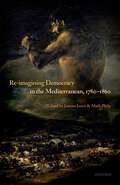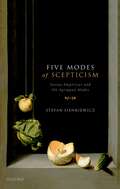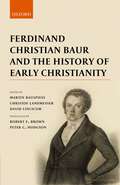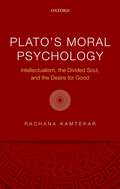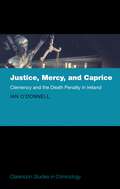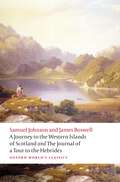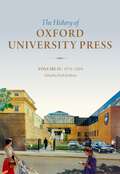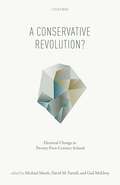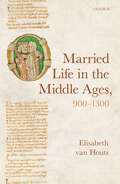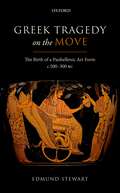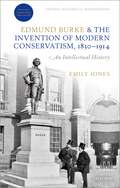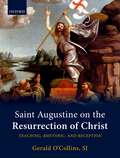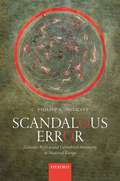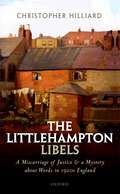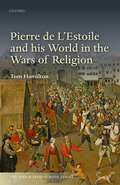- Table View
- List View
Re-Imagining Democracy in the Mediterranean, 1780-1860
Mediterranean states are often thought to have 'democratised' only in the post-war era, as authoritarian regimes were successively overthrown. On its eastern and southern shores, the process is still contested. Re-imagining Democracy looks back to an earlier era, the late eighteenth and early nineteenth centuries, and argues it was this era when some modern version of 'democracy' in the region first began. By the 1860s, representative regimes had been established throughout southern Europe, and representation was also the subject of experiment and debate in Ottoman territories. Talk of democracy, its merits and limitations, accompanied much of this experimentation - though there was no agreement as to whether or how it could be given stable political form. Re-imagining Democracy assembles experts in the history of the Mediterranean, who have been exploring these themes collaboratively, to compare and contrast experiences in this region, so that they can be set alongside better-known debates and experiments in North Atlantic states. States in the region all experienced some form of subordination to northern 'great powers'. In this context, their inhabitants had to grapple with broader changes in ideas about state and society while struggling to achieve and maintain meaningful self-rule at the level of the polity, and self-respect at the level of culture. Innes and Philip highlight new research and ideas about a region whose experiences during the 'age of revolutions' are at best patchily known and understood, as well as to expand understanding of the complex and variegated history of democracy as an idea and set of practices.
Re-Imagining Democracy in the Mediterranean, 1780-1860
by Mark Philp Joanna InnesMediterranean states are often thought to have 'democratised' only in the post-war era, as authoritarian regimes were successively overthrown. On its eastern and southern shores, the process is still contested. Re-imagining Democracy looks back to an earlier era, the late eighteenth and early nineteenth centuries, and argues it was this era when some modern version of 'democracy' in the region first began. By the 1860s, representative regimes had been established throughout southern Europe, and representation was also the subject of experiment and debate in Ottoman territories. Talk of democracy, its merits and limitations, accompanied much of this experimentation - though there was no agreement as to whether or how it could be given stable political form. Re-imagining Democracy assembles experts in the history of the Mediterranean, who have been exploring these themes collaboratively, to compare and contrast experiences in this region, so that they can be set alongside better-known debates and experiments in North Atlantic states. States in the region all experienced some form of subordination to northern 'great powers'. In this context, their inhabitants had to grapple with broader changes in ideas about state and society while struggling to achieve and maintain meaningful self-rule at the level of the polity, and self-respect at the level of culture. Innes and Philip highlight new research and ideas about a region whose experiences during the 'age of revolutions' are at best patchily known and understood, as well as to expand understanding of the complex and variegated history of democracy as an idea and set of practices.
Five Modes of Scepticism: Sextus Empiricus and the Agrippan Modes (Oxford Philosophical Monographs)
by Stefan SienkiewiczFive Modes of Scepticism examines the argument forms that lie at the heart of Pyrrhonian scepticism as expressed in the writings of Sextus Empiricus. These are the Agrippan modes of disagreement, hypothesis, infinite regression, reciprocity and relativity; modes which are supposed to bring about that quintessentially sceptical mental state of suspended judgement. Stefan Sienkiewicz analyses how the modes are supposed to do this, both individually and collectively, and from two perspectives. On the one hand there is the perspective of the sceptic's dogmatic opponent and on the other there is the perspective of the sceptic himself. Epistemically speaking, the dogmatist and the sceptic are two different creatures with two different viewpoints. The book elucidates the corresponding differences in the argumentative structure of the modes depending on which of these perspectives is adopted. Previous treatments of the modes have interpreted them from a dogmatic perspective; one of the tasks of the present work is to reorient the way in which scholars have traditionally engaged with the modes. Sienkiewicz advocates moving away from the perspective of the sceptic's opponent - the dogmatist - towards the perspective of the sceptic and trying to make sense of how the sceptic can come to suspend judgement on the basis of the Agrippan modes.
Ferdinand Christian Baur and the History of Early Christianity
Ferdinand Christian Baur (1792-1860) has been described as "the greatest and at the same time the most controversial theologian in German Protestant theology since Schleiermacher." The controversy was epitomized by a nineteenth-century British critic who wrote that his theory "makes of Christianity a thing of purely natural origin, calls in question the authenticity of all but a few of the New Testament books, and makes the whole collection contain not a harmonious system of divine truth, but a confused mass of merely human and contradictory opinions as to the nature of the Christian religion." The contributors to this volume, however, regard Baur as an epoch-making New Testament scholar whose methods and conclusions, though superseded, have been mostly affirmed during the century and a half since his death. This collection focuses on the history of early Christianity, although as a historian of the church and theology Baur covered the entire field up to own time. He combined the most exacting historical research with a theological interpretation of history influenced by Kant, Schelling, and Hegel. The first three chapters discuss Baur's relation to Strauss, Möhler, and Hegel. Then a central core of chapters considers his historical and exegetical perspectives (Judaism and Hellenism, Gnosticism, New Testament introduction and theology, the Pauline epistles, the Synoptic Gospels, John, the critique of miracle, and the combination of absoluteness and relativity). The final chapters view his influence by analyzing the reception of Baur in Britain, Baur and Harnack, and Baur and practical theology. This work offers a multi-faceted picture of his thinking, which will stimulate contemporary discussion.
Ferdinand Christian Baur and the History of Early Christianity
by Robert F. Brown David Lincicum Martin Bauspiess Christof Landmesser Peter C. HodgsonFerdinand Christian Baur (1792-1860) has been described as "the greatest and at the same time the most controversial theologian in German Protestant theology since Schleiermacher." The controversy was epitomized by a nineteenth-century British critic who wrote that his theory "makes of Christianity a thing of purely natural origin, calls in question the authenticity of all but a few of the New Testament books, and makes the whole collection contain not a harmonious system of divine truth, but a confused mass of merely human and contradictory opinions as to the nature of the Christian religion." The contributors to this volume, however, regard Baur as an epoch-making New Testament scholar whose methods and conclusions, though superseded, have been mostly affirmed during the century and a half since his death. This collection focuses on the history of early Christianity, although as a historian of the church and theology Baur covered the entire field up to own time. He combined the most exacting historical research with a theological interpretation of history influenced by Kant, Schelling, and Hegel. The first three chapters discuss Baur's relation to Strauss, Möhler, and Hegel. Then a central core of chapters considers his historical and exegetical perspectives (Judaism and Hellenism, Gnosticism, New Testament introduction and theology, the Pauline epistles, the Synoptic Gospels, John, the critique of miracle, and the combination of absoluteness and relativity). The final chapters view his influence by analyzing the reception of Baur in Britain, Baur and Harnack, and Baur and practical theology. This work offers a multi-faceted picture of his thinking, which will stimulate contemporary discussion.
Plato's Moral Psychology: Intellectualism, the Divided Soul, and the Desire for Good
by Rachana KamtekarPlato's Moral Psychology is concerned with Plato's account of the soul and its impact on our living well or badly, virtuously or viciously. The core of Plato's moral psychology is his account of human motivation, and Rachana Kamtekar argues that throughout the dialogues Plato maintains that human beings have a natural desire for our own good, and that actions and conditions contrary to this desire are involuntary (from which follows the 'Socratic paradox' that wrongdoing is involuntary). Our natural desire for our own good may be manifested in different ways: by our pursuit of what we calculate is best, but also by our pursuit of pleasant or fine things - pursuits which Plato assigns to distinct parts of the soul. Kamtekar develops a very different interpretation of Plato's moral psychology from the mainstream interpretation, according to which Plato first proposes that human beings only do what we believe to be the best of the things we can do ('Socratic intellectualism') and then in the middle dialogues rejects this in favour of the view that the soul is divided into parts with some good-dependent and some good-independent motivations ('the divided soul').
Justice, Mercy, and Caprice: Clemency and the Death Penalty in Ireland (Clarendon Studies in Criminology)
by Ian O'DonnellJustice, Mercy, and Caprice is a work of criminal justice history that speaks to the gradual emergence of a more humane Irish state. It is a close examination of the decision to grant clemency to men and women sentenced to death between the end of the civil war in 1923 and the abolition of capital punishment in 1990. Frequently, the decision to deflect the law from its course was an attempt to introduce a measure of justice to a system where the mandatory death sentence for murder caused predictable unfairness and undue harshness. In some instances the decision to spare a life sprang from merciful motivations. In others it was capricious, depending on factors that should have had no place in the government's decision-making calculus. The custodial careers of those whose lives were spared repay scrutiny. Women tended to serve relatively short periods in prison but were often transferred to a religious institution where their confinement continued, occasionally for life. Men, by contrast, served longer in prison but were discharged directly to the community. Political offenders were either executed hastily or, when the threat of capital punishment had passed, incarcerated for extravagant periods. This book addresses issues that are of continuing relevance for countries that employ capital punishment. It will appeal to scholars with an interest in criminal justice history, executive discretion, and death penalty studies, as well as being a useful resource for students of penology.
Justice, Mercy, and Caprice: Clemency and the Death Penalty in Ireland (Clarendon Studies in Criminology)
by Ian O'DonnellJustice, Mercy, and Caprice is a work of criminal justice history that speaks to the gradual emergence of a more humane Irish state. It is a close examination of the decision to grant clemency to men and women sentenced to death between the end of the civil war in 1923 and the abolition of capital punishment in 1990. Frequently, the decision to deflect the law from its course was an attempt to introduce a measure of justice to a system where the mandatory death sentence for murder caused predictable unfairness and undue harshness. In some instances the decision to spare a life sprang from merciful motivations. In others it was capricious, depending on factors that should have had no place in the government's decision-making calculus. The custodial careers of those whose lives were spared repay scrutiny. Women tended to serve relatively short periods in prison but were often transferred to a religious institution where their confinement continued, occasionally for life. Men, by contrast, served longer in prison but were discharged directly to the community. Political offenders were either executed hastily or, when the threat of capital punishment had passed, incarcerated for extravagant periods. This book addresses issues that are of continuing relevance for countries that employ capital punishment. It will appeal to scholars with an interest in criminal justice history, executive discretion, and death penalty studies, as well as being a useful resource for students of penology.
A Journey to the Western Islands of Scotland and the Journal of a Tour to the Hebrides (Oxford World's Classics)
by Samuel Johnson James BoswellIn 1773, James Boswell made a long-planned journey across the Scottish Highlands with his English friend Samuel Johnson; the two spent more than a hundred days together. Their tour of the Hebrides resulted in two books, A Journey to the Western Islands of Scotland (1775), a kind of locodescriptive ethnography and Johnson's most important work between his Shakespeare edition and his Lives of the Poets. The other, Boswell's Journal of a Tour to the Hebrides with Samuel Johnson (1785), a travel narrative experimenting with biography, the first application of the techniques he would use in his Life of Samuel Johnson (1791). These two works form a natural pair and, owing that they cover much of the same material, are often read together, focusing on the Scottish highlands. The text presents a lightly-edited version of both works, preserving the original orthography and corrected typographical errors to fit modern grammar standards. The introduction and notes provide clear and concise explanations on Johnson and Boswell's respective careers, their friendship and grand biographical projects. It also examines the Scottish Enlightenment, the status of England and Scotland during the Reformation through to the Union of the Crowns, and the Jacobite
A Journey to the Western Islands of Scotland and the Journal of a Tour to the Hebrides: A Journey To The Western Islands Of Scotland And The Journal Of A Tour To The Hebrides (Oxford World's Classics #21)
by James Boswell Samuel JohnsonIn 1773, James Boswell made a long-planned journey across the Scottish Highlands with his English friend Samuel Johnson; the two spent more than a hundred days together. Their tour of the Hebrides resulted in two books, A Journey to the Western Islands of Scotland (1775), a kind of locodescriptive ethnography and Johnson's most important work between his Shakespeare edition and his Lives of the Poets. The other, Boswell's Journal of a Tour to the Hebrides with Samuel Johnson (1785), a travel narrative experimenting with biography, the first application of the techniques he would use in his Life of Samuel Johnson (1791). These two works form a natural pair and, owing that they cover much of the same material, are often read together, focusing on the Scottish highlands. The text presents a lightly-edited version of both works, preserving the original orthography and corrected typographical errors to fit modern grammar standards. The introduction and notes provide clear and concise explanations on Johnson and Boswell's respective careers, their friendship and grand biographical projects. It also examines the Scottish Enlightenment, the status of England and Scotland during the Reformation through to the Union of the Crowns, and the Jacobite
The History of Oxford University Press: 1970 to 2004 (History of Oxford University Press)
The story of Oxford University Press spans five centuries of printing and publishing. Beginning with the first presses set up in Oxford in the fifteenth century and the later establishment of a university printing house, it leads through the publication of bibles, scholarly works, and the Oxford English Dictionary, to a twentieth-century expansion that created the largest university press in the world, playing a part in research, education, and language learning in more than 50 countries. With access to extensive archives, the four-volume History of OUP traces the impact of long-term changes in printing technology and the business of publishing. It also considers the effects of wider trends in education, reading, and scholarship, in international trade and the spreading influence of the English language, and in cultural and social history - both in Oxford and through its presence around the world. In the decades after 1970 Oxford University Press met new challenges but also a period of unprecedented growth. In this concluding volume, Keith Robbins and 21 expert contributors assess OUP's changing structure, its academic mission, and its business operations through years of economic turbulence and continuous technological change. The Press repositioned itself after 1970: it brought its London Business to Oxford, closed its Printing House, and rapidly developed new publishing for English language teaching in regions far beyond its traditional markets. Yet in an increasingly competitive worldwide industry, OUP remained the department of a major British university, sharing its commitment to excellence in scholarship and education. The resulting opportunities and sometimes tensions are traced here through detailed consideration of OUP's business decisions, the vast range of its publications, and the dynamic role of its overseas offices. Concluding in 2004 with new forms of digital publishing, The History of OUP sheds new light on the cultural, educational, and business life of the English-speaking world in the late twentieth century.
The History of Oxford University Press: 1970 to 2004 (History of Oxford University Press)
by Simon Eliot Keith RobbinsThe story of Oxford University Press spans five centuries of printing and publishing. Beginning with the first presses set up in Oxford in the fifteenth century and the later establishment of a university printing house, it leads through the publication of bibles, scholarly works, and the Oxford English Dictionary, to a twentieth-century expansion that created the largest university press in the world, playing a part in research, education, and language learning in more than 50 countries. With access to extensive archives, the four-volume History of OUP traces the impact of long-term changes in printing technology and the business of publishing. It also considers the effects of wider trends in education, reading, and scholarship, in international trade and the spreading influence of the English language, and in cultural and social history - both in Oxford and through its presence around the world. In the decades after 1970 Oxford University Press met new challenges but also a period of unprecedented growth. In this concluding volume, Keith Robbins and 21 expert contributors assess OUP's changing structure, its academic mission, and its business operations through years of economic turbulence and continuous technological change. The Press repositioned itself after 1970: it brought its London Business to Oxford, closed its Printing House, and rapidly developed new publishing for English language teaching in regions far beyond its traditional markets. Yet in an increasingly competitive worldwide industry, OUP remained the department of a major British university, sharing its commitment to excellence in scholarship and education. The resulting opportunities and sometimes tensions are traced here through detailed consideration of OUP's business decisions, the vast range of its publications, and the dynamic role of its overseas offices. Concluding in 2004 with new forms of digital publishing, The History of OUP sheds new light on the cultural, educational, and business life of the English-speaking world in the late twentieth century.
A Conservative Revolution?: Electoral Change in Twenty-First Century Ireland
by Michael Marsh David M. Farrell Gail McElroyThe 2011 general election in the Republic of Ireland, which took place against a backdrop of economic collapse, was one of the most dramatic ever witnessed. The most notable outcome was the collapse of Fianna Fáil, one of the world's most enduring and successful parties. In comparative terms Fianna Fáil's defeat was among the largest experienced by a major party in the history of parliamentary democracy. It went from being the largest party in the state (a position it had held since 1932) to being a bit player in Irish political life. And yet ultimately, there was much that remained the same, perhaps most distinctly of all the fact that no new parties emerged. It was, if anything, a 'conservative revolution'. A Conservative Revolution? examines underlying voter attitudes in the period 2002-11. Drawing on three national election studies the book follows party system evolution and voter behaviour from boom to bust. These data permits an unprecedented insight into a party system and its voters at a time of great change, as the country went through a period of rapid growth to become one of Europe's wealthiest states in the early twenty-first century to economic meltdown in the midst of the international Great Recession, all of this in the space of a single decade. In the process, this study explores many of the well-established norms and conventional wisdoms of Irish electoral behaviour that make it such an interesting case study for comparison with other industrialized democracies.
Married Life in the Middle Ages, 900-1300 (Oxford Studies in Medieval European History)
by Elisabeth van HoutsMarried Life in the Middle Ages, 900-1300 contains an analysis of the experience of married life by men and women in Christian medieval Europe, c. 900-1300. The study focusses on the social and emotional life of the married couple rather than on the institutional history of marriage, breaking it into three parts: Getting Married - the process of getting married and wedding celebrations; Married Life - the married life of lay couples and clergy, their sexuality, and any remarriage; and Alternative Living - which explores concubinage and polygyny, as well as the single life in contrast to monogamous sexual unions. In this volume, van Houts deals with four central themes. First, the tension between patriarchal family strategies and the individual family member's freedom of choice to marry and, if so, to what partner; second, the role played by the married priesthood in their quest to have individual agency and self-determination accepted in their own lives in the face of the growing imposition of clerical celibacy; third, the role played by women in helping society accept some degree of gender equality and self-determination to marry and in shaping the norms for married life incorporating these principles; fourth, the role played by emotion in the establishment of marriage and in married life at a time when sexual and spiritual love feature prominently in medieval literature.
Married Life in the Middle Ages, 900-1300 (Oxford Studies in Medieval European History)
by Elisabeth van HoutsMarried Life in the Middle Ages, 900-1300 contains an analysis of the experience of married life by men and women in Christian medieval Europe, c. 900-1300. The study focusses on the social and emotional life of the married couple rather than on the institutional history of marriage, breaking it into three parts: Getting Married - the process of getting married and wedding celebrations; Married Life - the married life of lay couples and clergy, their sexuality, and any remarriage; and Alternative Living - which explores concubinage and polygyny, as well as the single life in contrast to monogamous sexual unions. In this volume, van Houts deals with four central themes. First, the tension between patriarchal family strategies and the individual family member's freedom of choice to marry and, if so, to what partner; second, the role played by the married priesthood in their quest to have individual agency and self-determination accepted in their own lives in the face of the growing imposition of clerical celibacy; third, the role played by women in helping society accept some degree of gender equality and self-determination to marry and in shaping the norms for married life incorporating these principles; fourth, the role played by emotion in the establishment of marriage and in married life at a time when sexual and spiritual love feature prominently in medieval literature.
Greek Tragedy on the Move: The Birth of a Panhellenic Art Form c. 500-300 BC
by Edmund StewartGreek tragedy is one of the most important cultural legacies of the classical world, with a rich and varied history and reception, yet it appears to have its roots in a very particular place and time. The authors of the surviving works of Greek tragic drama-Aeschylus, Sophocles, and Euripides-were all from one city, Athens, and all lived in the fifth century BC; unsurprisingly, it has often been supposed that tragic drama was inherently linked in some way to fifth-century Athens and its democracy. Why then do we refer to tragedy as 'Greek', rather than 'Attic' or 'Athenian', as some scholars have argued? This volume argues that the story of tragedy's development and dissemination is inherently one of travel and that tragedy grew out of, and became part of, a common Greek culture, rather than being explicitly Athenian. Although Athens was a major panhellenic centre, by the fifth century a well-established network of festivals and patrons had grown up to encompass Greek cities and sanctuaries from Sicily to Asia Minor and from North Africa to the Black Sea. The movement of professional poets, actors, and audience members along this circuit allowed for the exchange of poetry in general and tragedy in particular, which came to be performed all over the Greek world and was therefore a panhellenic phenomenon even from the time of the earliest performances. The stories that were dramatized were themselves tales of travel-the epic journeys of heroes such as Heracles, Jason, or Orestes- and the works of the tragedians not only demonstrated how the various peoples of Greece were connected through the wanderings of their ancestors, but also how these connections could be sustained by travelling poets and their acts of retelling.
Edmund Burke and the Invention of Modern Conservatism, 1830-1914: An Intellectual History (Oxford Historical Monographs)
by Emily JonesBetween 1830 and 1914 in Britain a dramatic modification of the reputation of Edmund Burke (1730-1797) occurred. Burke, an Irishman and Whig politician, is now most commonly known as the 'founder of modern conservatism' - an intellectual tradition which is also deeply connected to the identity of the British Conservative Party. The idea of 'Burkean conservatism' - a political philosophy which upholds 'the authority of tradition', the organic, historic conception of society, and the necessity of order, religion, and property - has been incredibly influential both in international academic analysis and in the wider political world. This is a highly significant intellectual construct, but its origins have not yet been understood. Emily Jones demonstrates, for the first time, that the transformation of Burke into the 'founder of conservatism' was in fact part of wider developments in British political, intellectual, and cultural history in the nineteenth and early twentieth centuries. Drawing from a wide range of sources, including political texts, parliamentary speeches, histories, biographies, and educational curricula, Edmund Burke and the Invention of Modern Conservatism shows how and why Burke's reputation was transformed over a formative period of British history. In doing so, it bridges the significant gap between the history of political thought as conventionally understood and the history of the making of political traditions. The result is to demonstrate that, by 1914, Burke had been firmly established as a 'conservative' political philosopher and was admired and utilized by political Conservatives in Britain who identified themselves as his intellectual heirs. This was one essential component of a conscious re-working of C/conservatism which is still at work today.
Edmund Burke and the Invention of Modern Conservatism, 1830-1914: An Intellectual History (Oxford Historical Monographs)
by Emily JonesBetween 1830 and 1914 in Britain a dramatic modification of the reputation of Edmund Burke (1730-1797) occurred. Burke, an Irishman and Whig politician, is now most commonly known as the 'founder of modern conservatism' - an intellectual tradition which is also deeply connected to the identity of the British Conservative Party. The idea of 'Burkean conservatism' - a political philosophy which upholds 'the authority of tradition', the organic, historic conception of society, and the necessity of order, religion, and property - has been incredibly influential both in international academic analysis and in the wider political world. This is a highly significant intellectual construct, but its origins have not yet been understood. Emily Jones demonstrates, for the first time, that the transformation of Burke into the 'founder of conservatism' was in fact part of wider developments in British political, intellectual, and cultural history in the nineteenth and early twentieth centuries. Drawing from a wide range of sources, including political texts, parliamentary speeches, histories, biographies, and educational curricula, Edmund Burke and the Invention of Modern Conservatism shows how and why Burke's reputation was transformed over a formative period of British history. In doing so, it bridges the significant gap between the history of political thought as conventionally understood and the history of the making of political traditions. The result is to demonstrate that, by 1914, Burke had been firmly established as a 'conservative' political philosopher and was admired and utilized by political Conservatives in Britain who identified themselves as his intellectual heirs. This was one essential component of a conscious re-working of C/conservatism which is still at work today.
Saint Augustine on the Resurrection of Christ: Teaching, Rhetoric, and Reception
by Gerald O'Collins, SJDespite an enormous amount of literature on St Augustine of Hippo, this work provides the first examination of what he taught about the resurrection of Jesus Christ. Augustine expounded Christ's resurrection in his sermons, letters, Answer to Faustus the Manichean, the City of God, Expositions of the Psalms, and the Trinity. Saint Augustine on the Resurrection of Christ: Teaching, Rhetoric, and Reception explores what Augustine held about the centrality of Christ's resurrection from the dead, the agency of Christ's resurrection, and the nature of his risen existence. Leading scholar, Gerald O'Collins, investigates the impact of his resurrection on others and his mediatory role as the risen High Priest. O'Collins then unpicks Augustine's rhetorical justification for the resurrection of Christ: evidence from creation, human history, and the desires of all human beings. This groundbreaking study illustrates the enduring significance of Augustine's teaching on and apologetic for the resurrection, and updates, augments, and corrects what Augustine held.
Saint Augustine on the Resurrection of Christ: Teaching, Rhetoric, and Reception
by Gerald O'Collins, SJDespite an enormous amount of literature on St Augustine of Hippo, this work provides the first examination of what he taught about the resurrection of Jesus Christ. Augustine expounded Christ's resurrection in his sermons, letters, Answer to Faustus the Manichean, the City of God, Expositions of the Psalms, and the Trinity. Saint Augustine on the Resurrection of Christ: Teaching, Rhetoric, and Reception explores what Augustine held about the centrality of Christ's resurrection from the dead, the agency of Christ's resurrection, and the nature of his risen existence. Leading scholar, Gerald O'Collins, investigates the impact of his resurrection on others and his mediatory role as the risen High Priest. O'Collins then unpicks Augustine's rhetorical justification for the resurrection of Christ: evidence from creation, human history, and the desires of all human beings. This groundbreaking study illustrates the enduring significance of Augustine's teaching on and apologetic for the resurrection, and updates, augments, and corrects what Augustine held.
Scandalous Error: Calendar Reform and Calendrical Astronomy in Medieval Europe
by C. Philipp NothaftThe Gregorian calendar reform of 1582, which provided the basis for the civil and Western ecclesiastical calendars still in use today, has often been seen as a triumph of early modern scientific culture or an expression of papal ambition in the wake of the Counter-Reformation. Much less attention has been paid to reform's intellectual roots in the European Middle Ages, when the reckoning of time by means of calendrical cycles was a topic of central importance to learned culture, as impressively documented by the survival of relevant texts and tables in thousands of manuscripts copied before 1500. For centuries prior to the Gregorian reform, astronomers, mathematicians, theologians, and even Church councils had been debating the necessity of improving or emending the existing ecclesiastical calendar, which throughout the Middle Ages kept losing touch with the astronomical phenomena at an alarming pace. Scandalous Error is the first comprehensive study of the medieval literature devoted to the calendar problem and its cultural and scientific contexts. It examines how the importance of ordering liturgical time by means of a calendar that comprised both solar and lunar components posed a technical-astronomical problem to medieval society and details the often sophisticated ways in which computists and churchmen reacted to this challenge. By drawing attention to the numerous connecting paths that existed between calendars and mathematical astronomy between the Fall of Rome and the end of the fifteenth century, the volume offers substantial new insights on the place of exact science in medieval culture.
Scandalous Error: Calendar Reform and Calendrical Astronomy in Medieval Europe
by C. Philipp NothaftThe Gregorian calendar reform of 1582, which provided the basis for the civil and Western ecclesiastical calendars still in use today, has often been seen as a triumph of early modern scientific culture or an expression of papal ambition in the wake of the Counter-Reformation. Much less attention has been paid to reform's intellectual roots in the European Middle Ages, when the reckoning of time by means of calendrical cycles was a topic of central importance to learned culture, as impressively documented by the survival of relevant texts and tables in thousands of manuscripts copied before 1500. For centuries prior to the Gregorian reform, astronomers, mathematicians, theologians, and even Church councils had been debating the necessity of improving or emending the existing ecclesiastical calendar, which throughout the Middle Ages kept losing touch with the astronomical phenomena at an alarming pace. Scandalous Error is the first comprehensive study of the medieval literature devoted to the calendar problem and its cultural and scientific contexts. It examines how the importance of ordering liturgical time by means of a calendar that comprised both solar and lunar components posed a technical-astronomical problem to medieval society and details the often sophisticated ways in which computists and churchmen reacted to this challenge. By drawing attention to the numerous connecting paths that existed between calendars and mathematical astronomy between the Fall of Rome and the end of the fifteenth century, the volume offers substantial new insights on the place of exact science in medieval culture.
The Littlehampton Libels: A Miscarriage of Justice and a Mystery about Words in 1920s England
by Christopher HilliardThe Littlehampton Libels tells the story of a poison-pen mystery that led to a miscarriage of justice in the years following the First World War. There would be four criminal trials before the real culprit was finally punished, with the case challenging the police and the prosecuting lawyers as much any capital crime. When a leading Metropolitan Police detective was tasked with solving the case, he questioned the residents of the seaside town of Littlehampton about their neighbours' vocabularies, how often they wrote letters, what their handwriting was like, whether they swore — and how they swore, for the letters at the heart of the case were often bizarre in their abuse. The archive that the investigation produced shows in extraordinary detail how ordinary people could use the English language in inventive and surprising ways at a time when universal literacy was still a novelty. Their personal lives, too, had surprises. The detective's inquiries and the courtroom dramas laid bare their secrets and the intimate details of neighbourhood and family life. Drawing on these records, The Littlehampton Libels traces the tangles of devotion and resentment, desire and manipulation, in a working-class community. We are used to emotional complexity in books about the privileged, but history is seldom able to recover the inner lives of ordinary people in this way.
The Littlehampton Libels: A Miscarriage of Justice and a Mystery about Words in 1920s England
by Christopher HilliardThe Littlehampton Libels tells the story of a poison-pen mystery that led to a miscarriage of justice in the years following the First World War. There would be four criminal trials before the real culprit was finally punished, with the case challenging the police and the prosecuting lawyers as much any capital crime. When a leading Metropolitan Police detective was tasked with solving the case, he questioned the residents of the seaside town of Littlehampton about their neighbours' vocabularies, how often they wrote letters, what their handwriting was like, whether they swore — and how they swore, for the letters at the heart of the case were often bizarre in their abuse. The archive that the investigation produced shows in extraordinary detail how ordinary people could use the English language in inventive and surprising ways at a time when universal literacy was still a novelty. Their personal lives, too, had surprises. The detective's inquiries and the courtroom dramas laid bare their secrets and the intimate details of neighbourhood and family life. Drawing on these records, The Littlehampton Libels traces the tangles of devotion and resentment, desire and manipulation, in a working-class community. We are used to emotional complexity in books about the privileged, but history is seldom able to recover the inner lives of ordinary people in this way.
Pierre de L'Estoile and his World in the Wars of Religion (The Past and Present Book Series)
by Tom HamiltonThe Wars of Religion embroiled France in decades of faction, violence, and peacemaking in the late sixteenth century. This study offers a new history of these Wars of Religion from the perspective of the period's great diarist and collector, Pierre de L'Estoile (1546-1611), telling the story of his life and times. When historians interpret these events they inevitably depend on sources of information gathered by contemporaries, none more valuable than the diaries and collection of Pierre de L'Estoile (1546-1611), who lived through the civil wars in Paris and shaped how they have been remembered ever since. Taking him out of the footnotes, and demonstrating his significance in the culture of the late Renaissance, this is the first life of L'Estoile in any language. It examines how he negotiated and commemorated the conflicts that divided France as he assembled an extraordinary collection of the relics of the troubles, a collection that he called 'the storehouse of my curiosities'. The story of his life and times is the history of the civil wars in the making. Focusing on a crucial individual for understanding Reformation Europe, this study challenges historians' assumptions about the widespread impact of confessional conflict in the sixteenth century. L'Estoile's prudent, non-confessional responses to the events he lived through and recorded were common among his milieu of Gallican Catholics. His life-writing and engagement with contemporary news, books, and pictures reveals how individuals used different genres and media to destabilise rather than fix confessional identities. Bringing together the great variety of topics in society and culture that attracted L'Estoile's curiosity, this volume rethinks his world in the Wars of Religion.
